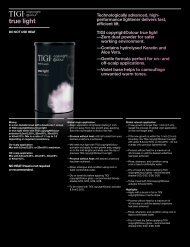For The Love Of Colour - TiGi
For The Love Of Colour - TiGi
For The Love Of Colour - TiGi
You also want an ePaper? Increase the reach of your titles
YUMPU automatically turns print PDFs into web optimized ePapers that Google loves.
hair<br />
elasticity<br />
hair science hair science<br />
Elasticity is the hair’s ability to stretch and return<br />
to its original form. When the hair is wet, it should<br />
stretch up to 40% of its length and retract<br />
(like a new elastic band).<br />
<strong>For</strong> hair that does not retract (like an old, worn<br />
elastic band), the condition is poor and chemical<br />
services are not recommended. Poor elasticity<br />
is a result of internal damage to the cortex and, like<br />
porous hair, it is nearly always uneven according to<br />
age and the abuse the hair has received. Causes<br />
can be electrical appliance damage, excessive sun<br />
exposure, overuse of processing chemicals, or<br />
misuse of chemicals for a particular hair type.<br />
You can naturally have fragile hair; however, as a<br />
rule, hair will become porous before having poor<br />
elasticity. Poor elasticity in hair means that the<br />
keratin (natural protein) has been damaged or<br />
weakened resulting in the hair losing its integrity.<br />
HOW TO TEST<br />
Take one single strand of hair from the area<br />
that is most affected. Wet the single strand to<br />
allow you to test the hair in its natural state.<br />
Keeping the base of the thumbs together,<br />
hold the hair between the thumb and the<br />
index finger and gently pull the hair, watching<br />
to see how much it retracts.<br />
You can describe the hair as having good,<br />
moderately sensitised, or highly sensitised<br />
elasticity. When the hair is anything more than<br />
moderately sensitised, extra warmth (0/66,<br />
0/44, 0/33 from TIGI copyright©olour mix<br />
master) may need to be incorporated within<br />
the refreshing technique. If the hair is highly<br />
sensitised, no chemical services should be<br />
recommended.<br />
Hair’s elasticity will change from time to time.<br />
Porous hair usually loses its elasticity faster than<br />
non-porous hair. This may be temporary due to<br />
humidity and temperature, the type of shampoo<br />
used, the amount of hair spray/gels used, and<br />
the drying action of wind and sun.<br />
Signs of poor elasticity<br />
When the hair is wet, it feels spongy, limp, tangles,<br />
and stretches excessively without returning to its<br />
normal position. <strong>The</strong> most common cause of this<br />
serious condition is chemical services such as<br />
colour, highlighting, perming, or straightening either<br />
being given improperly or repeated too often, or<br />
both. Elasticity damage can also be caused by<br />
brushing wet hair, stretching it beyond its limit.<br />
It is important to assess the elasticity or<br />
sensitivity before colouring every client. This will<br />
help to determine the correct colour product,<br />
activator strength, application, and refreshing<br />
technique required to help maintain condition,<br />
colour longevity, and results.<br />
hair<br />
condition<br />
<strong>The</strong> condition is the overall state and cosmetic<br />
feel of the hair. This describes how the hair feels<br />
with a blow dry and after finishing product has<br />
been applied. This will not give a true reading<br />
of the internal structure of the hair, which is<br />
needed prior to a chemical service.




